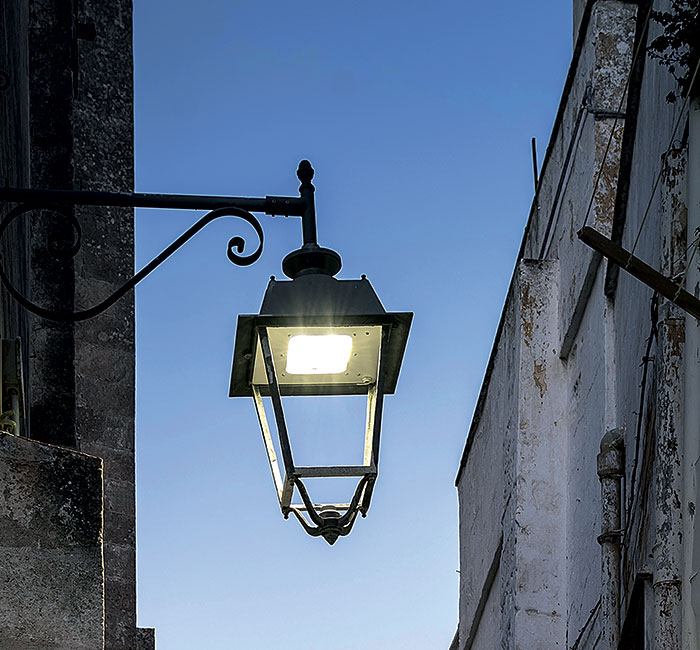Artistic, environmental and historical testimonies of the oldest part of a municipality, i.e., its historic center, always needs to be properly preserved. This is why historic centers are subject to special protection also when it comes to lighting.
Lighting is a means for preserving the beauty of historic centers, so it needs a precise lighting study to guarantee its quality.
Historic centers are the heart of citizens’ social life and a strong tourist attraction.
In Niteko, we work on both street and urban lighting projects– for which we provide our experience and our luminaires’ efficiency – in order to guarantee a proper and environment-friendly lighting.
At international level, Czech Republic is one of the European countries with whom Niteko collaborates the most. This Country is particularly attentive to environmental protection.
Unlike Italy, it has less natural light at certain times of the year. Hence its greater sensitivity to the relationship between lighting and environmental protection. This is a deep-rooted concept within Czech society, to such an extent that Czech Ministry of Health published its guidelines to be followed when working on urban lighting in order to guarantee visual comfort, road safety and respect of health in every city; useful – in our opinion – for any urban lighting project.

Criteria to be met for a quality urban lighting
Good visibility
Visual comfort for pedestrians and drivers is fundamental.
Actually, this is why men started looking for artificial lighting methods to compensate for the lack of natural light during the night.
Therefore, it is important to use a good color rendering index (CRI>70) to improve both light quality and color sharpness.
Safety
The number of accidents and thefts decreases significantly when the city has a good lighting system. People link light to safety and feel more comfortable when walking in a well-lit place rather than in a dim light.
Aesthetics
The result of a good lighting project is comfortable environments where luminaires merge with the urban context from an aesthetic point of view. This happens when luminaire’s profiles are in line with the environment, making it pleasant and balanced.
Affordability
The possibility of saving money is among the first customers’ requests. LED luminaires are an investment allowing to get back the costs within three years and to save up to 70%.
Service life of traditional lighting fixtures lasts no longer of 5 years. On the contrary, LED lighting fixtures last up to 20 years, thus guaranteeing significantly reduced maintenance costs.
We suggest investing a little more today, to earn a lot more tomorrow.
Pay also attention to price differences: if LED lighting fixtures are too inexpensive, maybe their quality is poor. Consequently, the product deteriorates rapidly and it needs to be replaced within few years.
Social function
Harmonious lighting has a positive impact on people and facilitates socialization, making evening walks under picturesque city’s skylines even more pleasant.
We always suggest choosing lighting fixtures with high color rendering index, in order to make the environment perceived as safe and comfortable.
The question of cold white light
In pedestrian crossings, our perception of road safety is related to cold white light, because it increases concentration in busy streets and allows drivers to immediately notice pedestrians.
The situation changes when it comes to historic centers.
Incorrect use of cold light could not only glare and bother pedestrians, but also the adjoining houses, thus altering the circadian rhythm of those who live there.
Instead, warm white stands for comfort and tranquility. It makes easier to relax and recreates the typical atmosphere full of warmth of the ancient historic centers illuminated by old lampposts.
Niteko fully maximizes LED’s efficiency and suggests using luminaires with ≤ 3,000 K color temperature – (2,200 K even better) which allow reducing light pollution risks, without renouncing LED’s high efficiency.
Generally, you should use 3,000 K color temperature in road sections and cold white only to illuminate pedestrian crossings and dangerous intersections, where the level of attention needs to be high.

Therefore, when illuminating historic centers the most important criteria to be followed are road safety and positive perception of city’s public spaces, closely linked to the goal of glare prevention.
Niteko optics are suitable for this purpose, because of the precision of their customized rotations. In this way, you avoid light disturbance, without sacrificing safety.
For urban environments, we suggest combining luminaires with 2,700 K or 2,200 K color temperature and CRI>70.
High color rendering index does not modify colors and gives high quality lighting
Compared CRIs (High color rendering index)
In the following pictures, you can see how the choice of proper color rendering index can make the difference for a quality lighting.

Amber LED luminaire, CRI=39

2,200 K LED luminaire, CRI=81
Both streets are illuminated by warm white light.
In the first case, you can see a distorted perception of the color and a poor visual sharpness reducing the sense of safety for pedestrians and increasing the risks of road accidents.
On the other hand, in the second case, Niteko’s lighting fixtures Guida guarantee both warm white light and high visual sharpness, thanks to their high color rendering index.
It is not color temperature that makes the difference, but CRI.
The situation in Italy
In Italy, Municipalities choose how to illuminate their historic centers and – since there are no national specific parameters – criteria are regulated by common sense and money-saving.
Through the PRIC (Municipal Lighting Regulator Plan), they plan the different types of city lighting and determine the goals to be achieved by the lighting installations:
- Minimize energy consumptions and save money
- Improve lighting systems’ efficiency
- Reduce light pollution
- Minimize maintenance costs
- Enhance both historic centers and urban contexts
- Make the municipal area safe in order to improve city life
- Program the switch-on and usage time of the luminaires
Therefore, the goal is to both enhance the historic centers by saving money, and guarantee safety by reducing light pollution.
Yet many Italian historic centers are illuminated by cold white LED luminaires, because there are no precise regulations, and municipal authorities often choose cold lights for greater savings. As a consequence, users complain about the modification of the urban atmosphere and criticize the impacts on Italian historical beauties. They say municipalities do not enhance Italian beauties because they prefer to save a meager 10%, which is the difference between warm white and cold white light.

In conclusion, although LED cold light provides greater safety and concentration in busy and dangerous streets, in our experience, we always suggest ≤ 3,000 K color temperature for historic centers. In addition, we guarantee an excellent color rendering with our Niteko lighting fixtures, which leave the warm light atmosphere of the historic centers unchanged and guarantee high visual comfort.
If you have any questions about our products or if you need assistance or information, please contact us by message, e-mail, or call us.
CONTACT US0 Comments
Leave a reply
You must be logged in to post a comment.




